Introduction
A space station has been an obvious part of space exploration since people began to think seriously about space travel. In 1923, Hermann Oberth published The Rocket into Interplanetary Space (1), which contained the first serious proposal for a manned space station to appear in scientific literature rather than fiction. Oberth suggested a permanent station supplied by smaller rockets, and he suggested rotation of the vehicle to produce artificial gravity for the crew. ”Such a station,” he said, ”could serve as a base for Earth observations, as a weather forecasting satellite, as a communications satellite, and as a refueling station for extraterrestrial vehicles launched from orbit.” He wrote from an engineer’s viewpoint, leaving out scientific research, but he included just about every other use for a station proposed since then.
The First Symposium on Space Flight was held on 12 October, 1951 at the Hayden Planetarium in New York City. Papers read at the symposium were published by Collier’s Magazine beginning in March 1952 and continuing to April 1954 under the title, ”Man Will Conquer Space Soon.” Contributors included Wernher von Braun, who laid out a manned space exploration program starting with sorties, progressing rapidly to a space station, and reaching the Moon in the year 2000 (2). Then, in 1959, von Braun advanced a theory for using a booster’s spent stage as a space station’s basic structure. This later evolved into the ”wet workshop” concept for what became Skylab, the world’s first space station.
The Cold War turned von Braun’s logical progression on its head. In 1959, the newly formed NASA was already propounding a lunar landing as a long-term goal, and in 1962, President Kennedy proclaimed it as the goal for NASA. A space station would have to wait.
But the goal remained, and as spacecraft and boosters for Project Apollo, NASA’s lunar landing program, were defined, space station concepts derived their specifics from them. Modifications of the Command Module, the Lunar Module, and various configurations of the Apollo booster series, were studied. NASA wanted to use its hardware for programs beyond Apollo. In 1965, the concept of Apollo Extension Systems was formalized at NASA Headquarters and very soon became the Apollo Applications Program (AAP). The concept later named Skylab was just one of the missions proposed by AAP (3).
Development
Skylab was a program that was being designed and trained for simultaneously, and the design and training were taking place in parallel with the Gemini, and later, the Apollo manned flights. Thus, the problems and experiences of those flights shaped the Skylab design.
Early NASA flights were conducted amid a sense of mystery as to how and whether humans would withstand the enigmatic environment of weightlessness and the confines of a tiny spacecraft. As the results came in, the astronauts seemed to hold up pretty well. But weight loss, loss of blood volume and muscle strength, some vestibular disturbances, and the suspicion that bones were thinning left unknown our ability to remain healthy and productive on long flights.
Answering this question was to be Skylab’s first goal. The second goal was to define the engineering arrangements needed for an effective human hotel/ laboratory in space. The third was to accomplish and demonstrate real first-class scientific returns in three fields: the study of the Sun, of Earth, and of the behavior of materials in weightlessness itself.
In 1966, these goals were still vague. AAP was still a rather primitive concept of using Apollo’s Saturn booster as an experimental space station. As Saturn evolved, one of its upper stages featured a restartable liquid hydrogen/ liquid oxygen engine. Called the “S-IVB” (pronounced ”Ess Four Bee”), it was the third stage of the Saturn V launch vehicle; it burned briefly to achieve Earth orbit, then restarted to boost the Command Service Module (CSM) and Lunar Module (LM) out of Earth orbit toward the Moon. It also formed the second stage of the smaller S-IB booster used in the earliest Apollo missions. It appeared to be a good candidate for manning (Fig. 1).
Between 1961 and 1965, the Marshall Space Flight Center (MSFC) conducted several studies to define the design and uses of space stations. In 1965, a formal study was begun of the ”S-IVB Spent Stage Workshop.” ”Spent stage” meant that the S-IVB was to be used as a working booster, and after its liquid hydrogen fuel was spent, the fuel tank would be vented, pressurized with oxygen, and used by the crew. The crew would dock with the spent stage, open the 48 large bolts that held the hatch in place, enter the stage, and spend time living in and evaluating the roomy but sparsely furnished volume.
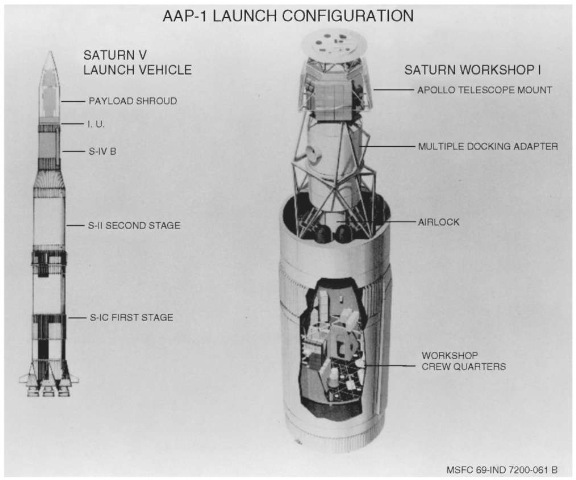
Figure 1. The Saturn V rocket launch configuration used to launch the Skylab module on the first Apollo Applications Program Flight (AAP-1) and also a cutaway drawing of the modified S-IVB that became Skylab.
On 19 August, 1966, George E. Mueller, NASA Associate Administrator for Manned Space Flight, used a felt pen and poster paper to pin down the final conceptual layout for the budding space station’s major elements (Fig. 2). In 1967, a four-flight AAP program was outlined that included two manned flights to the “Spent Stage Workshop.”
Of course, the engineers at Marshall Space Flight Center wanted to outfit the workshop as fully as possible before launch. But the challenge of providing wiring and other equipment that could withstand a bath of several hours’ duration in liquid hydrogen and then function reliably was proving difficult and limiting.
Suddenly, that changed, and a decision that was bad for Apollo turned out to be good for Skylab. The last three manned visits to the Moon, Apollos 18, 19, and 20, were canceled for budgetary reasons. Their boosters, the mighty three-stage Saturn Vs, became available. A Saturn V used its third stage, the same friendly S-IVB, to launch the Apollo spacecraft from Earth orbit to the Moon. Just to go to Earth orbit did not require it to function at all as a booster. It could be launched dry, and all the needed equipment would be preinstalled. There was lots of weight available. The Dry Workshop was born (Fig. 1).
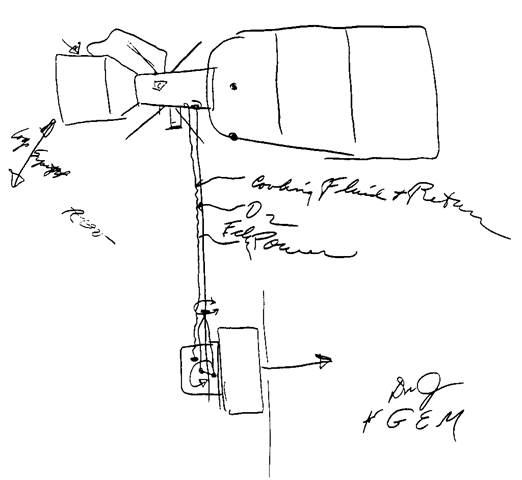
Figure 2. The sketch made by Dr. George Mueller, NASA Associate Administrator for Manned Space Flight, on 19 August, 1966 to illustrate the basic components of what eventually became Skylab.
The new configuration allowed a significant upgrade of the medical experiment complex. Real in-flight data could now be collected. The major experiments became an exercise tolerance experiment using a bicycle ergometer and a mass spectrometer to measure oxygen consumption and carbon dioxide production; lower body negative pressure to measure the crew’s probable response to reentry at end-of-mission; vestibular experiments featuring a rotating chair to stimulate and characterize space motion sickness; an electroencephalogram (EEG) to measure the duration and effectiveness of sleep; and a complete and accurate intake and output study that involved measuring and sampling every drop of urine, drying and returning feces, and accounting for every gram and calorie of food. Blood would be drawn weekly.
Another AAP mission being developed used the Apollo Lunar Module (LM) as the core for a solar physics mission. A cluster of cameras and telescopes optimized to study the Sun above the blockage and distortion of Earth’s atmosphere would be mounted in the LM descent stage; the controls and displays would be in the ascent stage where Apollo crews normally lived. The crew would arrive in an Apollo Command/Service Module (CSM), dock, perform experiments, and then return to Earth in the same CSM. The modified LM, called the ”Apollo Telescope Mount,” ATM for short, generated a lot of scientific enthusiasm. But as the 1960s progressed, it became apparent that there was not going to be enough money to carry it out. When the Dry Workshop and its Saturn V booster and huge weight capacity became available, the ATM (without a separate ascent stage) was grafted onto it, and it became the scientific crown jewel of Skylab.
The Earth Resources Experiment package was a relative latecomer, but a good one. The idea was to use the crew’s eyes and hands to select and point high-resolution, multispectral cameras at all kinds of phenomena on land and ocean— meteorological, crop, habitation and pollution, and natural phenomena such as volcanic eruptions. A capable set of cameras was located on the Earth-pointing side of the docking adapter (a cylindrical section that connected the Workshop with the docked CSM and also contained the ATM controls and displays and a lot of systems equipment).
The final major addition was the materials science package, notably a furnace for melting metal, creating alloys, and studying these processes in the absence of gravity-induced convection. In addition, literally dozens of smaller individual experiments were added to the mix. Some were devised by students at American schools.
First Mission
After many delays, the launch of the Skylab Orbital Workshop (OWS) was scheduled for 14 May, 1973, to be followed 24 hours later by the launch of the first crew (Fig. 3). The crew was commanded by Navy Captain Charles Conrad, Jr.,a very experienced astronaut, who had flown a previous record-setting long duration flight (Gemini V for 8 days), then commanded Gemini X and Apollo 12, the second lunar landing flight. (A rather short man, he was famous for his stirring words on that occasion: ”This may have been a small step for Neil, but it’s a giant leap for me!”) His crewmates were this author, Joe Kerwin, a Navy flight surgeon, and Paul Weitz, a Navy test pilot.
The crew watched the Workshop launch from the roof of their training building, apparently a complete success. But at about 36 seconds into the launch, mission control observed a g-spike, a brief but heavy jolt to the booster just as it went supersonic. Launch continued without any apparent problems; the correct circular orbit of 235 nautical miles was achieved.
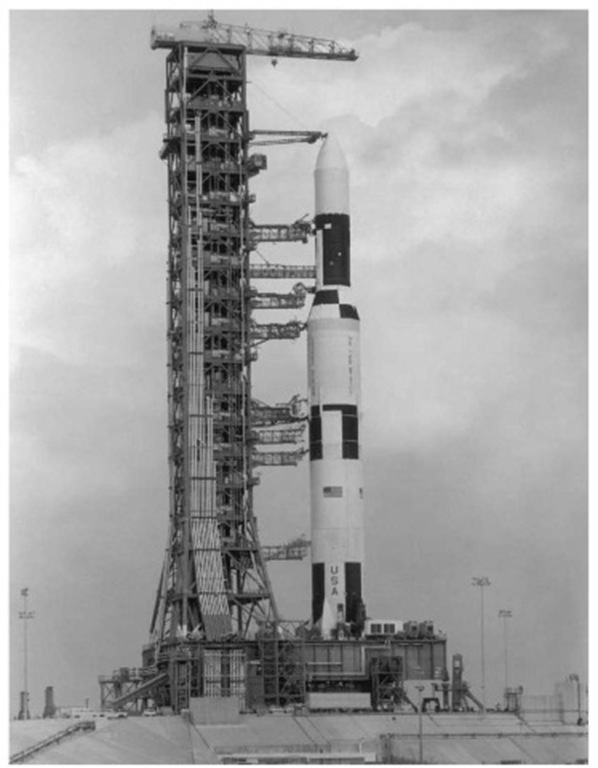
Figure 3. The Skylab Module ready for launch on 14 May, 1973. Note the absence of the escape tower at the top of the stack. Becasue no people were on board, the escape rocket was deemed unnecessary.
The problems were revealed when the deployment sequence of the Workshop was attempted.
First, the ”Apollo Telescope Mount,” the complex of solar physics experiments that had its own set of solar panels for electrical energy, was commanded to rotate out 90° and deploy its solar panels. This operation was completed. Next, the two large solar panels on the Workshop needed to be deployed. They were accordion-folded inside a pair of covers, which in turn were hinged and folded down flush with the sides of the OWS. Beneath them was the last item needing deployment: a cylindrical heat/micrometeoroid shield made of stout aluminum, wrapped around the OWS side walls. Springs were to expand and deploy it about 6 inches away from the OWS walls, where it would reflect solar energy away and break up micrometeorites.
When the OWS solar panels were commanded to deploy, there was no response from the starboard panel at all. A tiny trickle ofcurrent was seen from the port panel, indicating partial deployment. Attempts to deploy the heat shield also brought no response. And when temperatures both outside and within the OWS began to rise sharply, the problem became obvious; the heat shield had deployed prematurely, during launch, and was gone.
The crew’s launch the next day was scrubbed, and the Skylab team evaluated the situation. There were two problems:
1. The absence of the heat shield was causing intolerable temperatures within the OWS, up to 135°F.
2. One of the two main solar panels appeared to be gone, and the other was stuck (mostly) closed. Two thirds of Skylab’s power was unavailable; only the solar panels on the ATM remained. Skylab’s systems and experiments would be crippled.
The engineering team immediately began developing jury-rigged solutions to the loss of the heat shield; in 10 days, three solutions were designed, built, tested, and loaded aboard the first crew’s spacecraft. Another team evaluated possible causes for the stuck solar panel and selected tools for the crew to use in an attempt to free it. Meanwhile, the flight control team worked to keep the workshop’s temperature under control by rotating it away from the Sun—but not so far as to lose all power from the remaining solar panels. Other teams assessed the systems status and medical safety of the damaged OWS and rewrote the mission rules.
Skylab, in an unusually high-inclination orbit (50°, allowing Earth photography across most of the populated land mass), passed directly over Cape Kennedy every 5 days. So, the first new opportunity to launch the crew into an orbit suitable for rendezvous was 20 May, 1973. But the repair hardware was not ready. Launch was set for 25 May, and it was successful.
Rendezvous with Skylab took place 8 hours after launch, and the crew visually confirmed the suspicions of the team about damage. Only one heavy aluminum strap, a fragment of the missing heat shield, seemed to be holding down the remaining solar panel. So the crew did an immediate ”space walk” from the command module side hatch; Weitz, with a shepherd’s crook, tried to pry the panel loose. But the strap was too strong. So, they contented themselves with taking and transmitting to Houston extensive television pictures of the damage and then (after a second EVA to fix the docking system) docked with Skylab.
On day 2, the first substitute heat shield was deployed through an experiment hatch on the sunny side of the Workshop — an ingenious “parasol,” built from telescoping fishing poles and lightweight nylon cloth. It worked; temperatures in the OWS began to drop. By the third day, it was cool enough to begin activation of workshop systems (Fig. 4).
The first 2 weeks of the first mission were conducted in semidarkness, as the crew performed what experiments they could while conserving precious power. Most lights were kept off; no hot drinks were allowed. The Earth resources experiments, which required the Skylab cluster to deviate from its normal attitude facing the Sun to one in which it tracked Earth’s surface, were abandoned after one disastrous attempt caused depleted batteries to drop offline. The medical work and some solar physics could be accomplished.
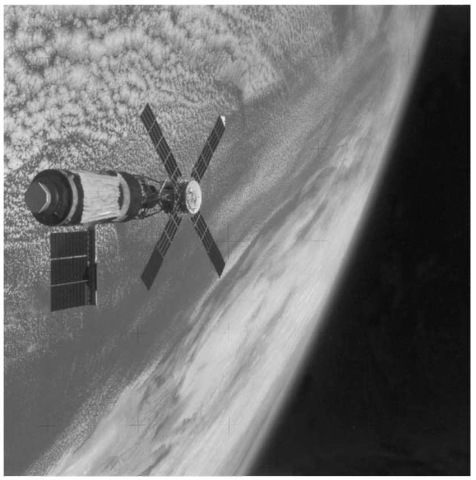
Figure 4. The final configuration of Skylab after the repair of the remaining solar panel and its deployment. The solar panel that should have been on the opposite side of the Spacelab vehicle was accidentally torn off when the shroud that covered the payload was lost during the launch sequence. The solar shield that prevented the spacecraft from getting too hot is the light colored area covering Skylab.
The Johnson Space Center engineers in Houston were working on a plan, and by day 10, they were ready to describe to the crew a recommended method for deploying the stuck solar panel. As anticipated, it required a space walk. No external maintenance had been planned for Skylab; the space suits were there only to retrieve and replace film from the solar telescope/cameras. But they were there, and the needed tools had launched with the crew: 25 feet of aluminum poles in 5-foot sections; a telephone company tree-limb lopper with lots of rope; and extra hooks and tethers. Even a dental saw from Skylab’s medical kit was taped to one suit, just in case. There were no handrails or footholds in the damaged area and no lighting.
Conrad and Kerwin went out on day 14, freed up the solar panel cover, and watched in joy as the accordion-packed panels, now exposed to the warming Sun, expanded. The power shortage was ended.
The remaining 2 weeks of the mission were a little too short to catch up completely on all of the planned experiments. But with power everything worked, and it was obvious that there would be a second and a third Skylab mission.
Splashdown in the Pacific Ocean west of San Diego occurred on 25 June within a mile of the waiting U.S.S. Kearsarge. For the first time, the intact command module was hoisted onto the carrier’s flight deck before the crew egressed, reducing the risk that a crew member weakened by long exposure to space would be unable to egress on the ocean and use the helicopter’s hoist. The crew was weary, but in good condition and spirits, able 3 days later to meet President Nixon and Soviet Premier Brezhnev in San Clemente.
Medically, the first crew
1. had lost from 5-10% percent of body weight;
2. had lost about 30% of arm strength and nearly 60% of leg strength; and
3. had lost about 10% of red cells from their blood, with no sign of new production.
4. by gamma ray imaging, had not lost appreciable bone calcium even after a month in space (although the very accurate intake-output study showed a net loss of calcium from the body).
Most importantly, the in-flight medical experiments showed a leveling-off effect after the first 2 weeks. Ability to exercise on the bicycle ergometer was fully maintained (muscles that were used did not weaken), weight loss did not continue, and performance and well-being were maintained. There was no reason not to continue the plan and expose the second crew twice as long.
Second Mission
On 28 July, 1973, the second crew launched to Skylab. Navy Captain Alan Bean, the commander, was a veteran of the Apollo 12 Moon landing. This was his first mission in command. His crewmates were Owen Garriott, a Ph.D. electrical engineer, and Jack Lousma, a Marine Corps test pilot.
Unfortunately, space motion sickness, which by the luck of the draw had been absent on the first mission, struck two of the three members of the Skylab II crew. Also, it remained true that activating a large space station was still a complex activity and required significant learning to handle oneself and one’s equipment, no matter how well trained one was. The result was that by the end of the first week Bean, Lousma, and Garriott found themselves healthy but behind their time line.
They pledged to recover by working overtime, if necessary, and they certainly did. The time required to perform experiments and maintenance activities decreases with repetition, and they worked at it long and hard. Dr. Garriott, the science pilot, declined to use the experimental shower in favor of additional runs of solar physics and student experiments.
The same disciplined approach was applied to crew exercise—increased over the first crew’s routine—to Earth photography and solar physics data collection, all of which were accomplished without incident. Data results from Sky-lab II were greater than planned, and in Houston, the Mission Control Team congratulated itself that it had finally learned how to schedule Skylab for optimum performance.
The accomplishments of this mission also included greatly expanding the scope of external repairs and maintenance activity conducted during three space walks and helping Arabella, the spider, to construct a web (she succeeded on the second try.)
From a medical perspective, the second crew returned from 59 days in space in as good condition as the first crew had after half as long. The increased exercise had not reversed the loss of muscle strength but had prevented it from going any deeper. Similarly, the loss of red cell mass actually recovered a bit after 4 weeks of decrease; their bodies were manufacturing erythrocytes again. Post-flight measurements showed that bone density had decreased linearly; that was still a long-term problem. Crew morale and performance and crew-ground teamwork were impeccable. NASA was justified in making the real-time decision to go for 84 days for the final Skylab crew.
Third Mission
Marine Corps Colonel Gerry Carr, scientist Ed Gibson, and test pilot Bill Pogue launched to the Skylab complex on 16 November, 1973, with plans for a third and final mission up to 84 days long—enough to ”certify” human stays of 3 months on a future space station or interplanetary trip.
Certain things in the background are important to understand the challenge and events of Skylab III:
1. Vietnam and the social revolution of the Baby Boomers had taken center stage in America; the supreme excitement of space exploration and its Cold War backdrop had abated. What was the message for Skylab? It was that there was not going to be a ”Skylab B” or any kind of near-term follow-up mission. The backup Skylab workshop would launch to the Smithsonian (where it can still be found), and scientific investigators knew that if any more data were to be wrung from this magnificent assortment of instruments, the third mission was their last chance. 2. NASA’s sole remaining new manned program was the Space Shuttle. NASA had argued that future space exploration of any kind necessitated lower cost access to Earth orbit; that this required a reusable vehicle; and that the fastest, most reliable way to design such a vehicle was to make it piloted. The implication was that we had shown that people could perform skilled tasks well in space and that DSMS (dreaded space motion sickness) was not going to stop them.
The third crew knew that the second crew had experienced motion sickness, and they had picked up the strong impression that the Shuttle program would prefer not to have a repetition. So, when one of them became motion sick and vomited during the first day, they discussed the matter on the intercom and decided not to bother Mission Control with it.
Unfortunately, they forgot that the intercom was routinely tape recorded and dumped to the ground. The result was a more or less public rebuke to the crew by their boss, Alan Shepard, which was not a morale-building way to get started onhuman’s longest voyage in space.
Add to this the fact, noted before, that Mission Control had learned how to schedule crews on Skylab for densely packed, productive workdays. What they did was to forget the steep learning curve both previous crews had demonstrated, and they began to overschedule Jerry Carr’s crew. The harder they worked, the “behinder” they got; the motion sickness incident hampered communications; and it was a few weeks into the flight before good communication took place and everybody got on the same page.
The rest is history. A repeat of history, actually; Skylab III followed Skylab Il’s path to high productivity. The crew exceeded all experiment goals, photographed the comet Kohoutek, observed the transit of Mercury across the Sun with instruments from the ATM, celebrated Christmas 250 miles up, grew beards, and in all things did honor to themselves and the Skylab team. They had been given more control over their time line and ran a ”shopping list” of additional experiments under their own control. This is the way to run a space station.
How did they do medically? Very well, indeed. They exercised even more than Bean’s crew. Because was noticed that leg strength was still being lost in space despite bicycle ergometer and isometric exercise, a treadmill was deemed needed. A conventional treadmill could not possibly be carried up in the space-limited CSM. It fell to Dr. William Thornton, a physician-engineer-astronaut who would not fly until the Shuttle was operational, to design one made of a sheet of slippery Teflon. The Teflon was pinned to the floor of the workshop near the bicycle. The rejected bicycle harness was found and taken out of stowage. The crew member used it to strap himself to the floor over the teflon strip, his body pitched forward about 30°, holding a handhold on the wall. Then wearing cotton socks, he ran in place (Fig. 5). It was not ideal, but it worked. The third crew came back from space with stronger muscles and less weight loss (Carr even gained a pound!) than any of their predecessors. Long duration human spaceflight had been proved both practical and productive (Figs. 6 and 7).
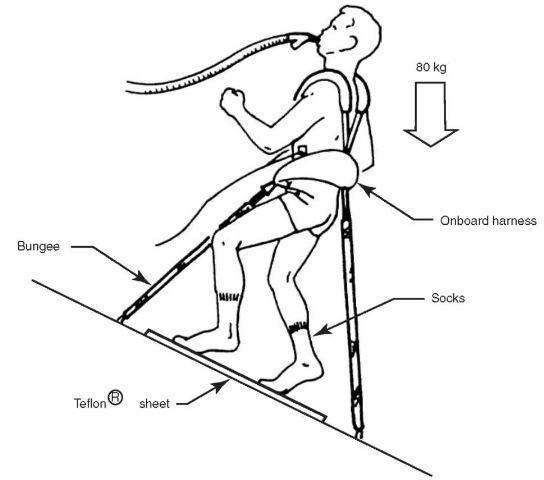
Figure 5. This drawing shows the Skylab treadmill devised by Astronaut Dr. William Thornton, a physician who is also an engineer.
It is worth noting that no significant illnesses or injuries occurred on any of the Skylab missions. The crew was, of course, rigorously screened for good health, so the odds were against a heart attack, stroke, or other major medical catastrophe. But the fact remains that whenever enough people spend enough time in space, there are going to be serious illnesses to deal with. Learning to do this is one of the goals of the International Space Station.
Summary
Skylab’s goals were to discover whether humans could live safely in weightlessness for 3 months, to uncover and solve any design problems living in space might present, and to demonstrate that productive science experiments could be accomplished. Here is a look at the results.
Medical. We have reviewed the results from each mission. We will now summarize the medical view of human spaceflight as seen at the conclusion of Skylab in 1974:
• Middle-aged male humans do quite well in space for as long as 3 months (and there is no reason to suppose that females will not do just as well).
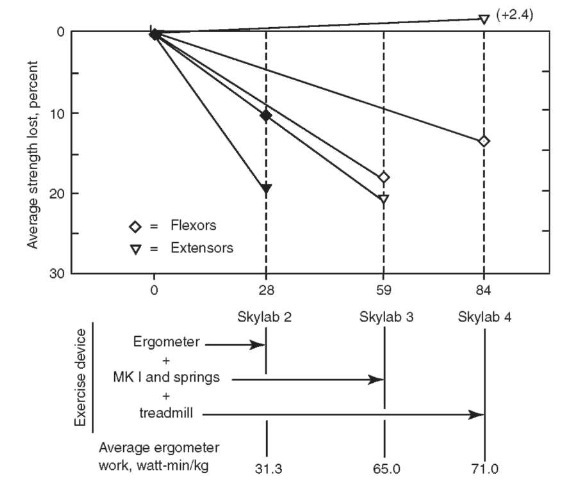
Figure 6. The graph illustrates the changes in average leg strength experienced by the Skylab astronauts during the three missions. It clearly shows the loss of leg strength in short missions from minimal exercise and then the maintenance of leg strength on longer missions from more intense exercise. The lower panel is a comparison among the various exercise devices that were used.
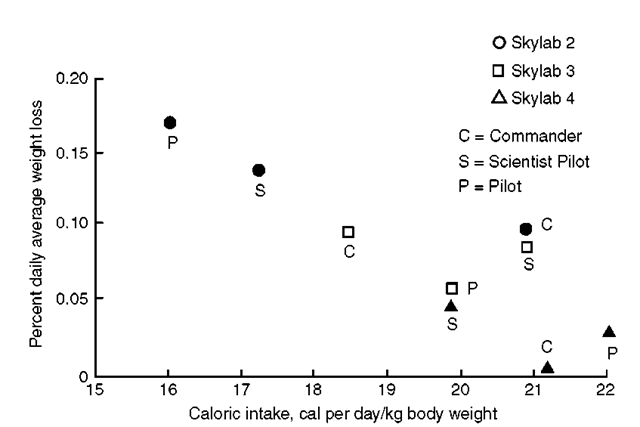
Figure 7. This graph shows the weight changes experienced by the nine Skylab astronauts as a function of caloric intake.
* However, weightlessness is stressful. It causes changes in our bodies, and although all are “adaptations” to the lack of gravity, some of them are harmful. Our ability to function upon return to Earth will be hampered if these changes are not mitigated by “countermeasures.” The most obvious and most successful countermeasure demonstrated on Skylab was exercise. It minimizes the loss of muscular mass, strength, and endurance which weightlessness produces, and also stresses and protects the cardiovascular system just as “aerobic” exercise does on Earth. It was clear that exercise was going to be a mandatory part of long-duration space explorers’ days.
Another class of changes occurred but appeared to be self-limited:
* motion sickness, until the vestibular system adapts (in less than a week);
* loss of fluid from the blood and extracellular fluid compartments (complete in about 3 days);
* reduction in the number of circulating red cells (complete in about a month).
A third class of changes did not respond to Skylab’s few and primitive countermeasures. Their long-term threats to health remain to be assessed and counteracted:
* loss of bone mineral mass and strength;
* changes in function of the immune system;
* life-shortening effects of damage from space radiation;
* ”cabin fever”—effects of the psychological stress of isolation and confinement. Skylab crews did not have a problem with this, but it remains a threat.
Work is being done today by NASA and the National Space Biomedical Research Institute (NSBRI) to develop countermeasures and test them on the International Space Station (ISS). Aside from the effects of weightlessness and confinement in a closed-up spacecraft, any time a group of humans lives in isolation for several months, illness or injury may occur. The practice of medicine in space poses some challenges:
1. Crew size is small. There may or may not be a physician on board. There certainly will not be a well-staffed operating room or even an emergency room. Trained people and the equipment they need are the primary shortages in space.
2. Weightlessness itself may confound diagnosis and complicate treatment.
3. Help is far away.
* How can these medical challenges be met and the risks minimized? For Skylab, the first tool was crew selection. Only people in excellent health and with few or no risk factors for disease were qualified for spaceflight in those days. And this method succeeded; no serious illness or injury occurred. The second was training. A physician flew only on the first crew, but two members of each crew were well trained in basic methods of diagnosis and treatment so that, under the direction of a flight surgeon in Houston, they could examine a crewmate and carry out some treatment procedures. The equipment on board approximated that in the office of a general practitioner, plus a dental kit that allowed procedures up to and including extraction. Finally, for serious problems, return to Earth was available. Skylab had an “ambulance,” the Apollo Command/Service Module, docked and ready to return an ill crew member.
Human Factors and Design. Skylab was built and flown in the dawn of human spaceflight, and it was a challenge posing and answering all the questions about how to design a hotel-cum-laboratory in which the curse and blessing of gravity were absent, and everything were afloat (Fig. 8). Questions, options and experiments were everywhere. Should the workspace be cylindrical, following the shape of its enclosure, with equipment around the outer walls, or should floors and ceilings be installed? (Skylab tried both.) How would people move from place to place—head first or belly button first? (The latter was preferred.) Were chairs needed? (No!) What sort of restraints worked best to attach you to where you were working, eating, or sleeping? And what is the best arrangement for going to the bathroom?
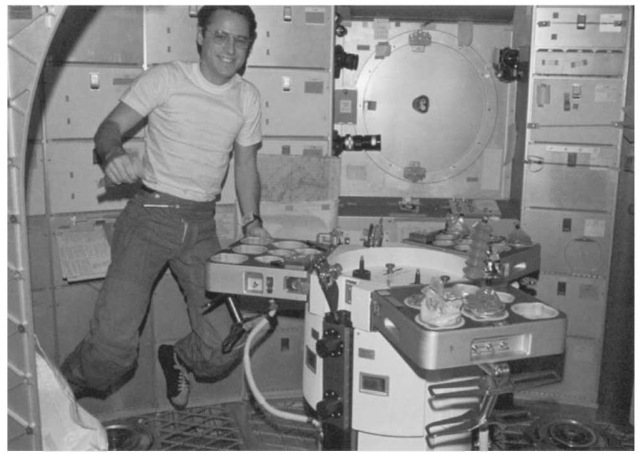
Figure 8. Astronaut Edward Gibson is shown “floating” next to the dinner table on Skylab. The third Skylab crew celebrated Thanksgiving in 1973 by having their turkey dinner at this table.
All of these ”human factors” questions were answered and documented beautifully in a series of ”Skylab Experience Bulletins” that defined every solution, from switch shapes to sleep stations. Space Station designers could proceed with confidence.
One of Skylab’s major achievements was unplanned—it demonstrated the practicality of external maintenance of a spacecraft by pressure-suited humans. Suits and an airlock were provided, but the only planned task was replacing film in some of the solar cameras. But Skylab’s launch problems created an opportunity to do much more. Erection of the stuck solar panel was successful, and subsequent trips outside included erecting a better solar shade for the workshop and repairs to camera doors and stuck relays. These successes helped to remove the aura of danger from spacewalks and has led to their extensive use in the Shuttle and ISS.
Knottier problems were those of maintaining a livable, comfortable environment in a completely closed space for a long time. Pressure, temperature, oxygen, and carbon dioxide content, humidity and contamination all had to be controlled. Skylab used a ”brute force” approach to these problems. Its life support system was ”open-loop”—all of the oxygen, nitrogen, clothing, water, and food needed for the three missions was launched with the workshop. Activated charcoal filters were used to control odor and contaminants and were replaced at intervals. Carbon dioxide was removed from the atmosphere by a ”molecular sieve”—it was trapped in the interstices of lava-like mineral beds, then dumped overboard as the beds were periodically exposed to vacuum. There was no attempt to reclaim oxygen or water from waste or to grow food. The system was not designed to be replenished or repaired—it was a prototype. This fact would hamper plans for revisiting Skylab after the Space Shuttle became available.
The system worked beautifully. However, on a trip to Mars, a system that does not recycle at least water will be prohibitively heavy. NASA has been working ever since on ”closed-loop” life support systems. Science and Human Productivity. The broad question asked of Skylab was this: could humans remain physically well in space and also function effectively as scientists? The broad answer was ”yes.” Weightlessness does not affect cognitive function in any unique way. The environment has its challenges; equipment needs to be designed with weightlessness in mind; any forgotten spares or tools will just have to be done without. But these constraints have been experienced—and overcome—by other expeditions, from Captain Bligh’s voyage to the present scientists at the South Pole.
The principal problem is the scarcity of people in orbit and hours in the day. The crew had to run the hotel, cook their own meals, and then do the experiments. Also, physical tasks learned on Earth must be re-learned in weightlessness. The first trial of a complex task takes more than twice as long in space; three or four repetitions are required to regain speed.
Nonetheless, the three Skylab crews became quite efficient, aided by the relative simplicity and good human engineering of the Skylab design. An average of 7.5 hours per person per day was used for science. The results were all that the investigators had hoped for:
• The medical results form the most complete and most accurate physiological data set ever collected in space. It has still not been equaled either by Russian or American flights.
• Astronomers published from the Skylab solar data and images for more than 20 years. Among the advances were the most complete and accurate measurements of solar flares, a huge increase in the observations of the solar corona, and unique records of the comet Kohoutek.
• Multispectral, targeted image sets of land, ocean, and meteorological features highlighted the Skylab Earth Observations program and stimulated a much better understanding of weather and climate. In addition, the crew members were privileged to see breathtaking views of their home planet (Fig. 9).
In summary, human-operated spacecraft were proven useful as scientific platforms, both as vantage points for Earth and astronomical observations above the atmosphere and as laboratories providing microgravity to physical and life scientists (5).
Epilogue: Skylab Returns to Earth, 1979
The final lesson of America’s first Space Station was that we had better plan more effectively how to dispose of our space assets. When the third mission to Skylab launched in November 1973, discussions of its future had already begun. It was considered possible that the Orbital Workshop could be revisited and even perhaps refurbished using the Space Shuttle then in development and due to be launched in 1979. That decision could wait, provided that after its final mission, Skylab was parked in a high enough orbit to remain aloft. The one thing to be avoided was a gradual decay of its orbit that resulted in uncontrolled reentry; there were some structural elements of Skylab that would survive reentry and could pose a threat to people and structures on Earth.
Of course, that is what happened, and here is why. The plan had been for the third crew, at the conclusion of their mission, to fire the Command and Service Module’s (CSM’s) 20,000-pound Service Propulsion System engine to raise the orbit of Skylab substantially—high enough to ensure an orbital lifetime of at least 10 years. But Rockwell engineers warned that the docking apparatus used to connect the CSM to the Workshop was too fragile and might sustain damage during the burn—might even risk damage to the CSM and endanger the crew. An altitude boost using the small reaction control system jets would raise the altitude sufficiently to keep Skylab in orbit until 1981, said the experts— 2 years after the initial flight of the Shuttle. So it was decided and accomplished.
This careful plan was then dismantled by two factors. The first was a 2-year slip in the Shuttle development schedule; the first launch was delayed until 1981. The second was the most active solar cycle yet recorded. As solar activity increased toward its 11-year peak in 1980, it heated the Earth’s upper atmosphere, increasing drag at Skylab’s altitude and hastening its decay. By 1978, it had become clear that Skylab was not going to make it. Now the only thing to do was to try to steer it to a safe reentry point.
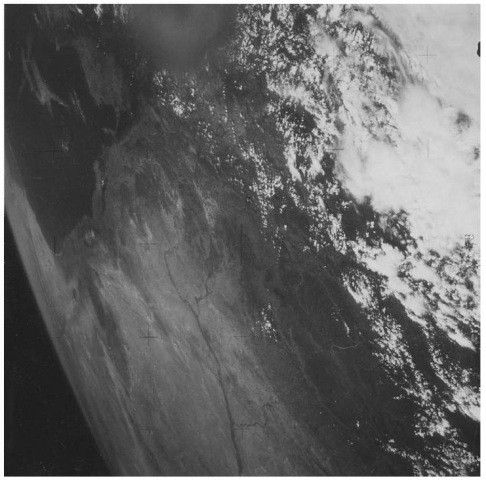
Figure 9. This picture was taken when Skylab was in orbit over eastern Turkey looking south. The eastern shore of the Mediterranean Sea is at the top center of the picture. The island of Cyprus is at the upper right, and the Nile River Delta is directly to the south (i.e., above) of Cyprus. The Euphrates River can be clearly seen in the center of the picture flowing east through Iraq. The Dead Sea, the Gulf of Aqaba, and the triangular Sinai Peninsula are visible at the top of the picture. In this one photograph, the Skylab crew was able to capture this view of the cradle of civilization.
The team assembled to monitor and attempt to control Skylab’s reentry did not have much to work with. Skylab had no propulsion system. All it had was an attitude control system consisting of control moment gyros, which had exceeded their lifetime and were failing, backed up by cold-gas jets whose nitrogen fuel was almost exhausted. So, very carefully, this team commanded Skylab to rotate in and out of its ”maximum drag” orientation, hoping to bring it to reentry altitude at just the right longitude to force it down over the Indian Ocean.
The reentry team did a remarkable job. They lost attitude control of Skylab over the North Atlantic on the fringes of the atmosphere. It continued over southern Africa, and finally broke up over the Indian Ocean west of Australia. Most of the debris fell into the ocean, but a little of it landed in southwestern Australia, east and south of Perth. Fortunately, this area is sparsely populated, and there was no injury or property damage. Many Australians found and returned pieces of Skylab to NASA for analysis of the effects of reentry. At least one proud Aussie had an intact, charred Skylab oxygen tank to hang over the front door of his pub. If you ever see it, reflect on how space flight has united the citizens of the world.
